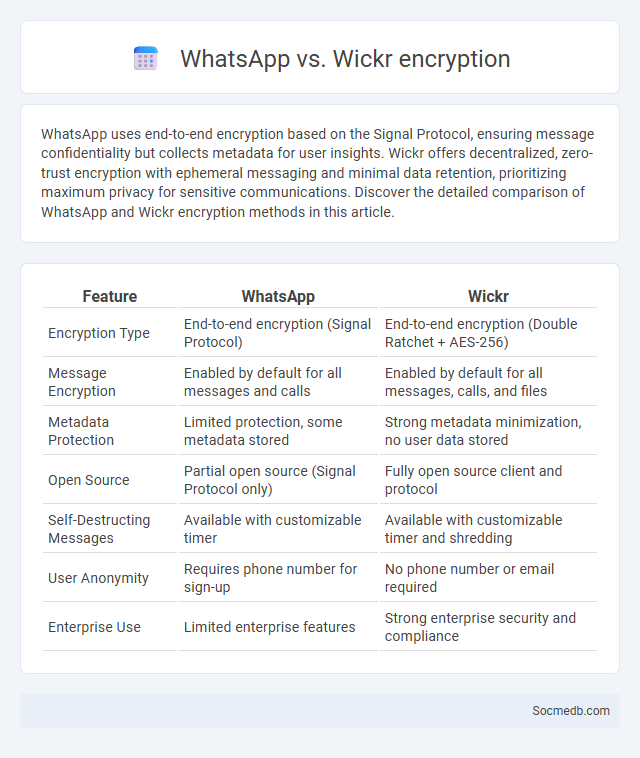
Photo illustration: WhatsApp vs Wickr encryption
WhatsApp uses end-to-end encryption based on the Signal Protocol, ensuring message confidentiality but collects metadata for user insights. Wickr offers decentralized, zero-trust encryption with ephemeral messaging and minimal data retention, prioritizing maximum privacy for sensitive communications. Discover the detailed comparison of WhatsApp and Wickr encryption methods in this article.
Table of Comparison
| Feature | Wickr | |
|---|---|---|
| Encryption Type | End-to-end encryption (Signal Protocol) | End-to-end encryption (Double Ratchet + AES-256) |
| Message Encryption | Enabled by default for all messages and calls | Enabled by default for all messages, calls, and files |
| Metadata Protection | Limited protection, some metadata stored | Strong metadata minimization, no user data stored |
| Open Source | Partial open source (Signal Protocol only) | Fully open source client and protocol |
| Self-Destructing Messages | Available with customizable timer | Available with customizable timer and shredding |
| User Anonymity | Requires phone number for sign-up | No phone number or email required |
| Enterprise Use | Limited enterprise features | Strong enterprise security and compliance |
Introduction to Messaging Encryption
Messaging encryption secures digital communications by converting messages into unreadable code, ensuring privacy and protection from unauthorized access. Advanced encryption standards (AES) and end-to-end encryption (E2EE) are commonly employed protocols that guarantee only intended recipients can decrypt and read the messages. Major platforms like WhatsApp, Signal, and Telegram utilize these encryption techniques to safeguard user conversations from interception and cyber threats.
What Is End-to-End Encryption?
End-to-end encryption (E2EE) ensures that messages sent between users on social media platforms are encrypted on the sender's device and only decrypted on the recipient's device, preventing third parties, including service providers, from accessing the content. This encryption method uses cryptographic keys that are unique to each user, enhancing privacy and security by safeguarding data from hackers, government surveillance, and unauthorized access. Popular social media apps like WhatsApp and Signal implement E2EE to protect user communications and maintain confidentiality.
WhatsApp: Encryption Features and Protocols
WhatsApp employs end-to-end encryption using the Signal Protocol, ensuring that only the sender and recipient can access the content of messages, calls, and shared media. This encryption method provides robust security by encrypting data on the sender's device and decrypting it only on the receiver's device, preventing interception by third parties, including WhatsApp itself. Continuous updates to its cryptographic protocols reinforce user privacy and protect against emerging cybersecurity threats in real-time communication.
Wickr: Encryption Features and Protocols
Wickr offers robust end-to-end encryption using the Double Ratchet protocol, which ensures your messages are securely transmitted and decrypted only by the intended recipient. Its zero-trust architecture combines symmetric and asymmetric encryption techniques to protect both data at rest and in transit. You benefit from ephemeral messaging features that automatically delete your content after a set time, enhancing privacy and security on social media platforms.
Key Differences: WhatsApp vs Wickr
WhatsApp offers end-to-end encryption primarily for personal messaging and group chats, emphasizing convenience and a large user base, while Wickr targets high-security communication with features like self-destructing messages and no metadata storage for enhanced privacy. Your choice depends on whether you prioritize widespread connectivity or stringent data protection. Both platforms use encryption, but Wickr's security protocols are more robust for sensitive conversations.
Security Strength: Assessing Encryption Standards
Your social media security strength depends heavily on the encryption standards implemented by the platform to protect your data from unauthorized access. End-to-end encryption and AES-256 protocols are critical elements that ensure messages and personal information remain confidential and secure. Regular updates and adherence to industry-leading security frameworks enhance the protection level, reducing the risk of data breaches and cyberattacks.
User Privacy: Data Collection and Metadata
Social media platforms collect vast amounts of user data and metadata, including location, device information, and interaction patterns, to personalize content and target advertisements. This extensive data collection raises significant privacy concerns as it can be exploited for profiling, behavioral analysis, and unauthorized data sharing. Users should be aware of privacy settings and data policies to better control how their personal information and metadata are used and stored.
Ease of Use and User Experience
Social media platforms prioritize ease of use to enhance your user experience, featuring intuitive interfaces and seamless navigation that require minimal learning curves. Streamlined content sharing, personalized feeds, and interactive elements keep users engaged while simplifying access to diverse features. These design principles ensure that users can effortlessly connect, communicate, and consume content across devices.
Vulnerabilities and Security Challenges
Social media platforms face critical vulnerabilities such as data breaches, phishing attacks, and exploitation of user-generated content, leading to privacy risks and identity theft. Your personal information and interactions can be targeted through sophisticated social engineering tactics that bypass traditional security measures. Strengthening authentication protocols and educating users on safe online behavior are essential to mitigating these security challenges.
Choosing the Right Encrypted Messenger
Selecting the right encrypted messenger hinges on robust end-to-end encryption protocols, ensuring that only the communicating users can read the messages. Platforms like Signal, Telegram, and WhatsApp offer varying levels of security features, including open-source code, metadata protection, and user verification methods. Prioritizing apps with a strong commitment to privacy, minimal data retention policies, and regular security audits enhances overall communication confidentiality on social media.
 socmedb.com
socmedb.com